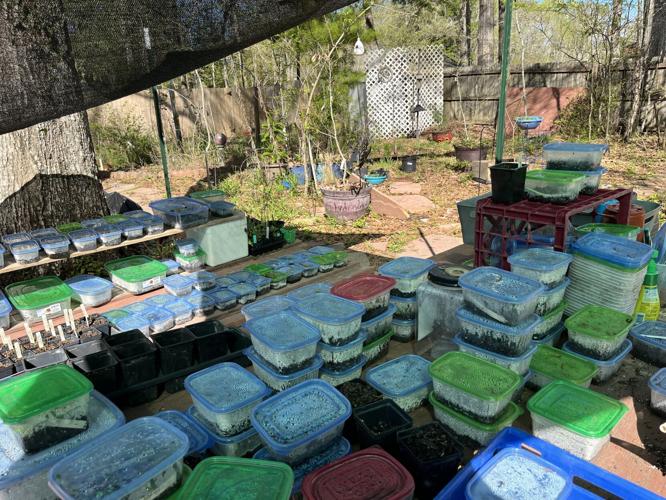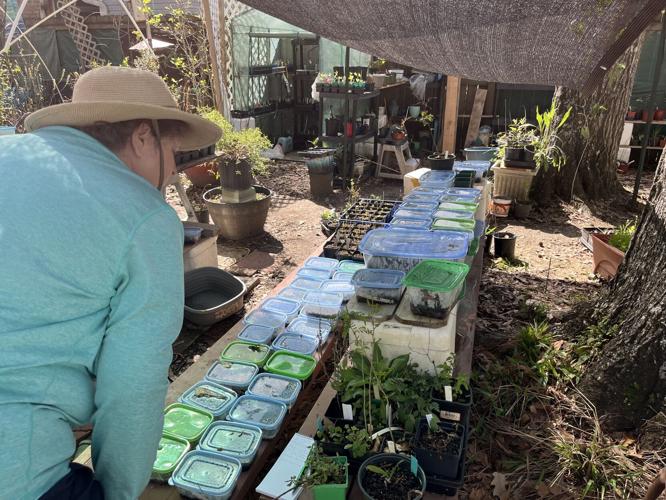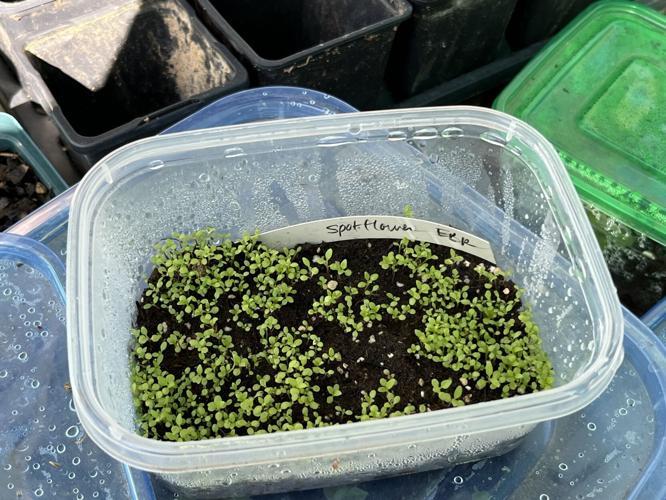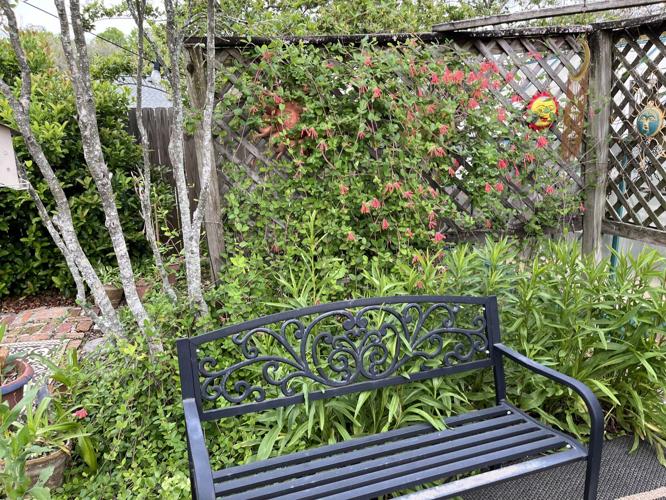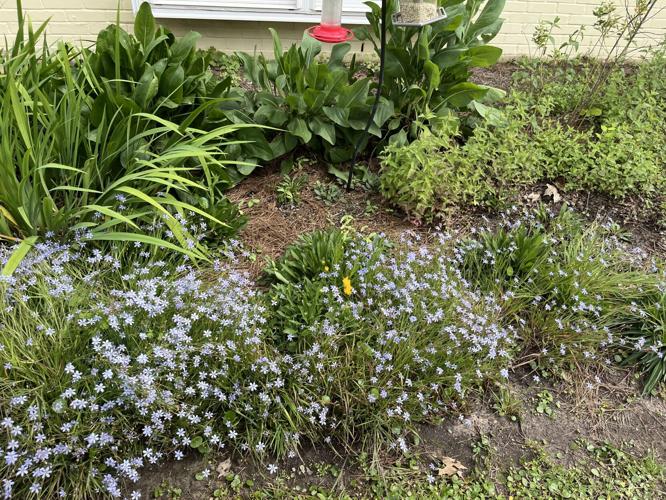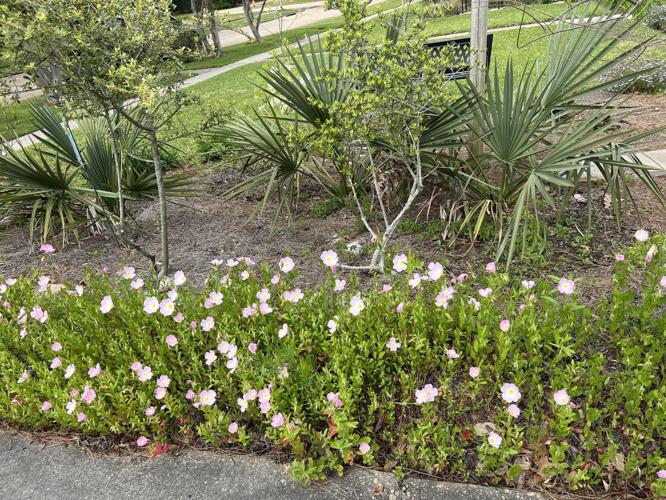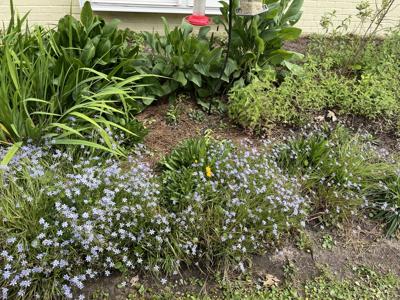Janine Kharey’s backyard is a maze of pots, planters and promise.
Her patio and yard are dotted with colors, fresh greens and multiple textures that will continually change from now until late fall. Her black cherry, chokeberry, cherry laurel and red mulberry trees have set fruit; there are blossoms on the sharp sepal beardtongue and yellow star grass as copper iris and swamp lily begin to bud and the fronds of sensitive fern unfurl. Sagittaria stalks jockey for a bit of sun among a dense growth of obedient plants and horsetail rushes.
These may be unfamiliar to many area gardeners because they are native plants that Kharey and her husband Alok Kharey specifically nurture to attract butterflies, bees and other pollinators. Three species of caterpillars live in their host trees and will ultimately transform into three types of swallowtail butterflies. In the meantime, numerous species of birds — bluebirds, Prothonotary Warblers, chickadees, Carolina wrens — either nest or visit the yard, attracted by the caterpillars to feed their nestlings.

Tables in Janine Kharey's back yard are covered with mini-greenhouses made of plastic food storage containers that protect hundreds of microscopic green seedlings.
It was, in fact, the magical transformation of caterpillar-to-butterfly known as metamorphosis that first attracted a 9-year-old Kharey to what became a lifetime journey seeking nature and which led her to establishing the Baton Rouge chapter of Wild Ones in 2022.
This national nonprofit, with 88 local groups in 35 states, serves to educate people about native plants and connect them to the diversity of plants that grow, or have grown, in their area, as well as to encourage the use of native plants in both private gardens and public spaces, to help restore natural landscapes.
“When we moved in, our yard was grass,” Kharey said. “Today there’s grass in part of the front yard only.”

Janine Kharey checks the progress of tiny green seedlings growing inside plastic containers. She will painstakingly pot these when they are large enough.
The Khareys retained a bank of large, old azaleas in the backyard because their pink flowers attract butterflies. Otherwise their patio and backyard comprise a dedicated workspace for cultivating a vast variety of native plants, many from seeds (of which some, she confesses, have been rescued from mowing machines along public roadways).
Tables are covered with mini-greenhouses made of plastic food storage containers that protect hundreds of microscopic green seedlings that she will painstakingly pot when they are large enough. Flats of immature plants bask beneath protective covers and nursery pots of all sizes hold a multitude of more mature plants. Some of these she will share or swap with other native plant enthusiasts; occasionally, she’ll sell them at public events where Wild Ones helps introduce the concept of gardening with native plants to attendees.
The concept of using native plants in gardens and public spaces has become important enough that Congress has declared April as National Native Plant month for the fourth year in a row. (The Louisiana Legislature is considering a resolution to do the same but, at this writing, it has not been passed.)

Corral honeysuckle, a native plant, adds a pop of color to Janie Braud's back yard.
Native plants are those that existed in the area before the European colonizers arrived. Unlike ornamentals and familiar cultivars, they are indigenous trees, shrubs, flowers and grasses called “flora” that evolved and thrived in these specific soils and climate.
Further, they interact with and support pollinators such as native bees, butterflies and moths as well as other wildlife that also evolved to live here so that together they create a balanced natural ecosystem.
Planting natives — whether in home gardens or public green spaces — helps recreate the historic biodiversity that once existed, offering an antidote to the urban development that has encroached on and destroyed so many natural areas.

When these green seedlings are large enough, Janine Kharey will painstakingly place them in pots, another step in the native plant cultivation process.
Planting a residential garden with natives has often received a bum rap, with visions of front lawns gone wild or a homeowner’s indifference to subdivision HOA covenants. This was probably the result of someone transforming a front yard sweep of St. Augustine into a native wildflower meadow. However, gardening with native plants can be done as artfully and attractively as any traditional landscape.
Native plantings have the additional perk of attracting native butterflies and birds which our familiar camellias, azaleas and crepe myrtles do not; going native doesn’t demand being a purist. The camellias and azaleas don’t have to be uprooted.
“It’s a misconception that a yard with natives can’t be planned,” Janie Braud said.
Braud and her family moved into their home more than 30 years ago, where she inherited a traditional landscape that she tended well. Upon becoming a member of Louisiana Master Naturalists of Greater Baton Rouge, however, she attended a presentation about planting natives and was instantly intrigued. In 2021, she converted a small section of her backyard to natives and then continued to add plants and beds until she realized she needed a professional landscape designer.

Pink Ladies are the perfect, colorful native choice to edge a driveway or sidewalk.
She wanted a thoughtful and effective design created to incorporate her expanding collection of native plants but realized “patience is required … many of the plants take several years to mature and fill in spaces.” But it’s worth it.
At the end of March, the Brauds’ front garden offered spring colors of baby-pink, poppy-shaped Pink Ladies and the pale blue of small star-shaped flowers festooning a dense sweep of Blue-eyed grass. Delicate, cream-colored flowers of a fringe tree, transplanted wild violets the color of LSU purple and sunflower yellow coreopsis all announced spring.
In her patio garden, coral honeysuckle draped densely over a trellis, a mass of emerald green leaves and pinky-red droops and a swath of deep green mountain mint sprawled like groundcover.
She anticipated yellow seaside goldenrod, small, white globe flowers of Rattlesnake Master, and feathery plumes of Inland sea oats. A Parsley Hawthorn tree will soon set delicate white cluster flowers, then red berries and native penstemon, salvia and ironweed will flower as well as blooming Turks Cap, spiderworts, frostweed and native iris.
With the help of a native plant landscape design professional, her plant materials have been placed according to the light and soil conditions of her yard. A native sedge reigns happily in what was an habitually damp and problem area, an example of how natives can be chosen for precisely the right reason. A privacy screen, for example, could be a stand of Dahoon holly, yaupon or Southern wax myrtle instead of ligustrum. Gardeners challenged by full sun, shade, a low spot, or clay soil can select native plants that have evolved to thrive in these specific conditions. And natives lend themselves well to both private and commercial plantings as well as along the neutral ground of a boulevard.
Best of all, gardens planted in mostly natives fared better than the non-natives during last summer’s extreme heat and drought and this winter’s freeze.
“Those of us with mostly natives did well during the drought and the freeze,” Braud said.
After all, they're used to living here.

